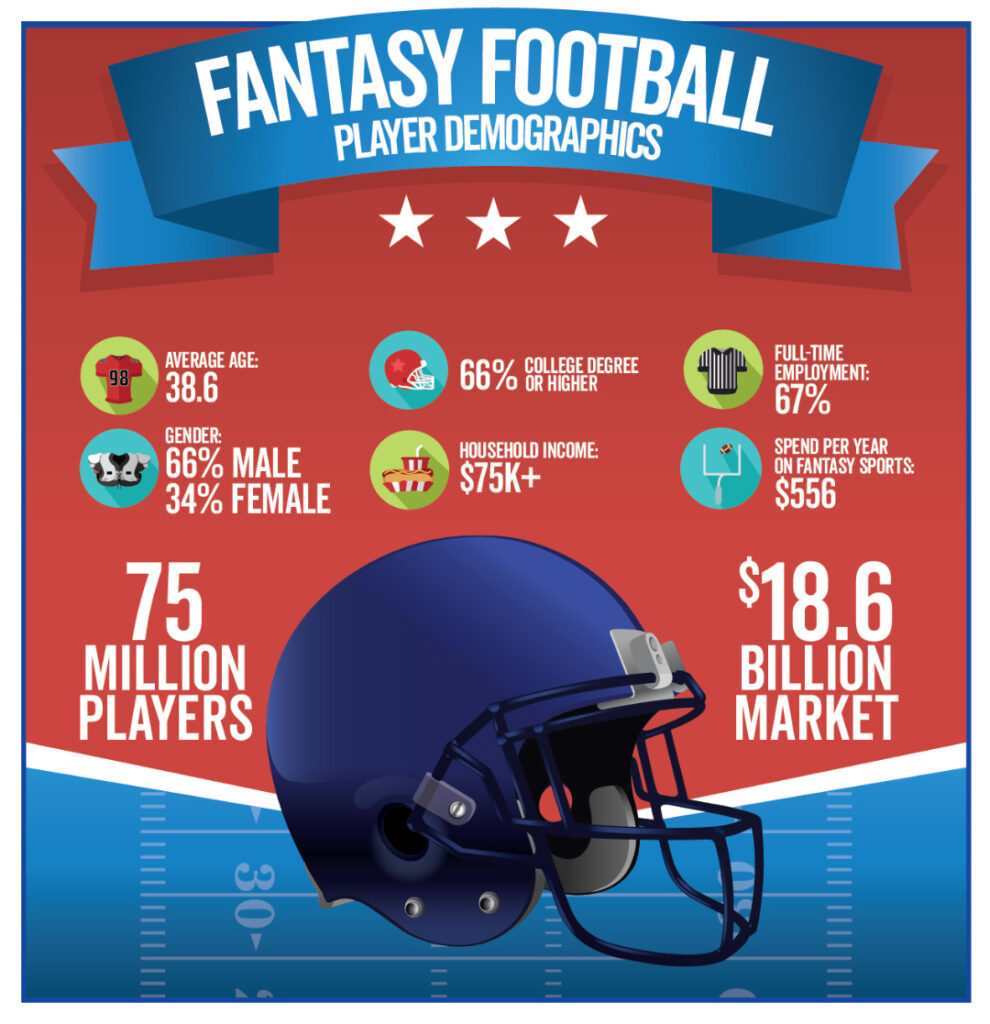If you’re any kind of football fan, or you share a water cooler with co-workers, you no doubt know how popular fantasy football is these days. Well, what started out in the early 1960s as a fun, fringe activity practiced by a bunch of numbers geeks, has grown phenomenally—having developed into a big—make that huge—industry.
So while your office pool might earn you a cool one or two hundred bucks at the end of the season, fantasy football, the industry, is powerfully generating billions of dollars through its websites and apps. To cash in on the frenzy, new companies have emerged like Fan Duel and Draft Kings—online, legalized gambling sites that offer fantasy players the chance to earn millions of dollars. (Take that, lowly office pools!)
As marketers, it’s hard not to keep an eye or two on what’s happening. Turns out fantasy football appeals to a pretty attractive demographic—one that any marketer would like to tap into. So we thought we’d take a look at this booming business and see what we could take away from a marketing perspective. (Sorry, you’ll have to look elsewhere for insights into this Sunday’s home Vikings-Texans matchup.)
It’s kind of a big deal
How big has fantasy football become? Some sources estimate that up to 75 million Americans participate in some kind of league, spending nearly $5 billion in the process. Today’s version of the game is a hardcore cultural phenomenon—one that attracts people from every walk of life. While the numbers vary depending on the source, fantasy football appears to be somewhere in the neighborhood of an $18.6 billion market. (Now that’s a pretty nice neighborhood!) Amazingly, that number is $6 billion more than the current estimated NFL revenue. With so many millions of people competing, and so many billions of dollars being won and lost, the fantasy football industry is certainly a lucrative one that marketers have started paying attention to in a big way.
Getting to know the players
Especially attractive to marketers is the fantasy football demographic. Around 60 percent of Americans say they follow the NFL, with about 25 percent participating in fantasy football leagues. Now, that itself is a lot of people. But when you look at who makes up the 25 percent, you find an audience that gets marketers pretty pumped up. According to the Fantasy Sports Trade Association (FSTA), fantasy sports players tend to be younger, better educated, have higher incomes, and are more likely to have full-time jobs. Here are some of the players’ stats:
On average, the FSTA estimates that fantasy sports players spend $556 a year. In terms of media consumption, 64% of fantasy players say they watch more live sports because of their fantasy league participation, with 61% saying it also motivates them to read more about sports, both print and online. In terms of technology, 39% of today’s fantasy sports players primarily use a mobile device versus 25% in 2012.
There are some appealing characteristics of the fantasy football player, as well—characteristics that marketers can use to their advantage. First of all, football fans tend to be a highly engaged, passionate audience. Their intense involvement in the game and support of their favorite teams and players makes them ideal consumers of anything related to those teams or players—including brand sponsors, ads messages, and other marketing tied to the game and their favorite teams. In addition, fantasy football appeals to a hard-to-reach demographic—including Millennials and the even younger Generation Z. So it’s a great way for marketers to find and get their message out to this somewhat elusive audience.
Fantasy football also helps marketers capture another challenging marketing demographic: high-income males, 25 to 50 years old. This is an audience that has become increasingly difficult to reach through television commercials, and which spends far more time on the Internet and on smartphones than watching TV or listening to radio.
An open field for marketers
In the last several years, some of the world’s biggest marketers have taken notice of the fantasy football surge and become sponsors—brands like Toyota, VW, Subway, DirecTV, and Unilever. However, while the potential for reaching the massive fantasy football audience is clear, marketers are still relatively inexperienced at developing ways to effectively reach them.
Traditionally, most companies advertising in fantasy football do so using banner ads. But a number of marketers believe these kinds of ads get ignored because most fans are too engrossed in the game content to pay attention to them. So to capture attention and better engage fans, marketers have tried to be more creative, providing helpful, relevant content through whatever means possible—whether it’s through ads, websites, videos, social media, and/or apps. Serving up fun, engaging content gives them better odds for capturing eyeballs and connecting to their audience. Even so, the potential is largely untapped, as marketers are still learning how best to reach the growing legions of fans, many of which spend hours each week glued to game-related websites and apps.
A positive impact on productivity?
Sure, this sounds like a great opportunity for marketers. But what about all those companies losing hours of productivity because their employees are checking stats, tweaking rosters, and debating Sunday’s matchups? Doesn’t fantasy football hurt productivity?
Actually, when it comes to productivity, fantasy football isn’t such a bad thing after all. According to outplacement services firm Challenger, Gray, and Christmas, Inc., the lost productivity due to fantasy football is approximately $17 billion a year. But that’s only part of the story.
Turns out, the benefits of fantasy football in the workplace seem to outweigh the negatives. Studies show fantasy football being good for employee morale and team building. In a study by human resources firm Peninsula, 62 percent of employees felt that company morale was boosted by participation in an office fantasy football league, with 49 percent saying it helped build co-worker relationships. Some studies also reveal that playing fantasy football can be a great networking tool that helps win new business and build client relationships.
The extra point
Well, there you have it. Fantasy football is big business—one that marketers are embracing, especially as its size and impact continues to grow. Its fan base is a highly desirable demographic that’s becoming increasingly diverse, and marketers are onlu just starting to figure out how best to reach them. But with all the questions still yet to be answered, one thing is for sure: Fantasy football provides a big marketing opportunity that’s only going to get bigger.
You can bet on it.
![cat[&]tonic](https://cat-tonic.com/wp-content/uploads/candt_logo-rw.png)





